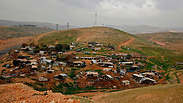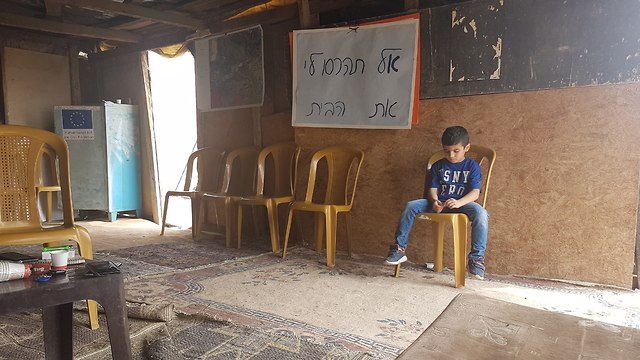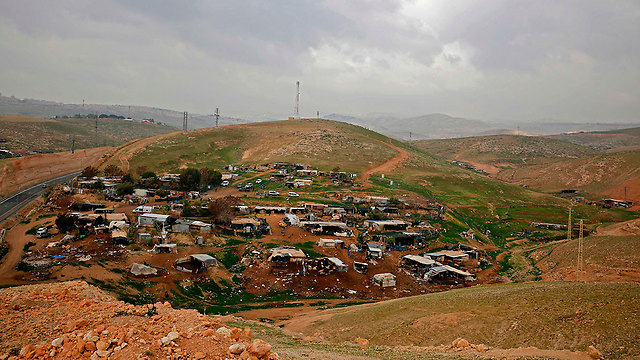


The silent transfer of Palestinians from Area C
Op-ed: Think about it: No infrastructure, no running water, no electricity and no educational framework for your children. You live under the constant fear of projectiles fired by training military forces, and all the while, the state destroys the few buildings and basic infrastructure you managed to build. Would you stay?
A total of 32 families—173 persons, including 92 children—will be expelled. All structures, including a school serving more than 150 children from Khan al-Ahmar and from neighboring Palestinian communities, will be demolished.
Khan al-Ahmar is but one of dozens of Palestinian communities under threat of expulsion. It will be the first such community in many years to be forcibly expelled in its entirety and relocated deep into the enclaves the state created for its Palestinian subjects in the West Bank, though such mass forcible transfers are rare in the West Bank.
In recent decades, however, Israeli policymakers have been trying to silently transfer Palestinians from all of Area C (the 60 percent of the West Bank that Israel exploits as though it were its own). The upcoming war crime in Khan al-Ahmar is merely an extreme example of an expulsion strategy that Israel is undertaking vis-a-vis all Palestinian communities in Area C, to create an environment that will coerce them into leaving.
The mechanical details of this environment are simple: The state forbids residents from connecting to infrastructural networks like water, sewage and electricity, prevents them from building legally, demolishes homes that residents had to build without permits, destroys basic infrastructure laid by them (such as solar panels, water containers and unpaved paths) and holds military training exercises that include firing live ammunition and shelling on agricultural land, in pastures and even within residential areas and between houses.
As in the case of Khan al-Ahmar, the state does not spare educational establishments: In the last year alone, the Civil Administration demolished two schools and one kindergarten in Area C—in Jub a-Dib in the Bethlehem area, in Jabal al-Baba in the Ma’ale Adumim area and in Khirbet Zanutah in the South Hebron Hills. This left 138 children with no educational framework. Today, 45 schools in Area C are under threat of partial or full demolition.
The vast majority of Palestinians in Area C cannot build legally without master plans. These do not fall from the sky, but have to be approved by the Civil Administration (spoiler alert: it never approves them).
In discussing the future of Khan al-Ahmar, the Supreme Court’s basic assumption was that the residents are criminals who built their homes illegally. Yet in the West Bank, Palestinians do not have the privilege of building legally outside the small, crowded enclaves the state allocates for them. The master plans they submit for approval are rejected time after time and when they do build, having run out of options, Israel responds with demolition.
In other words: The state has created an unbearable daily reality for Palestinians in Area C in order to make them leave as though of their own free will. These actions are part of a deliberate, premeditated policy aimed at expelling Palestinian residents from Area C and building (and expanding) settlements in their place. A Western-liberal state in theory; silent transfer of an entire population in practice.
If we take a few steps back and look at Israel’s policy in the Occupied Territories since the Oslo Accords, a clear picture emerges. Israel is trying to concentrate Palestinians in the tiniest enclaves possible, while taking over as much land as it can. This policy is twofold: For Palestinians, creating unbearable living conditions to make them transfer themselves; for Jews, building and expanding settlements.
Think about it. No infrastructure, no running water, no electricity and no educational framework for your children. You live under the constant whir of projectiles fired by training military forces, and all the while, the state destroys the few buildings and basic infrastructure you managed to lay out. Would you stay?
Although Israel has been carrying out this policy of silent expulsion for years, the forcible transfer of Khan al-Ahmar’s residents to the dumpster in Abu Dis is a horrific escalation. No more coercion, no more leaving-as-though-freely, but a violent transfer out in the open. By the book.
There is no telling how this decision might affect other Palestinian communities in Area C. However, Israel’s heightened motivation to accelerate the process of expulsion, coupled with the green light given by the Supreme Court in the case of Khan al-Ahmar, is a bad omen for other Palestinian communities—especially those that have legal processes pending a Supreme Court decision. These include Khirbet Umm al-Jamal and Khirbet Ein al-Hilweh in the Northern Jordan Valley, Abu a-Nuwar and Jabal al-Baba in the Ma’ale Adumim area, and the residents of Susiya and the South Hebron Hills in general.
At the end of the day, whether this policy of expulsion is enacted silently over many years, and whether it morphs into open forcible transfer in Khan al-Ahmar and elsewhere, Israeli policymakers bear criminal liability for it. The prime minister, the minister of defense and the head of the Civil Administration are all responsible. The fact that Supreme Court justices openly authorized this war crime exposes the complicity of Israel’s legal system with dispossession and forcible transfer.
Rida Abu Rass is a data coordinator at B’Tselem.

















